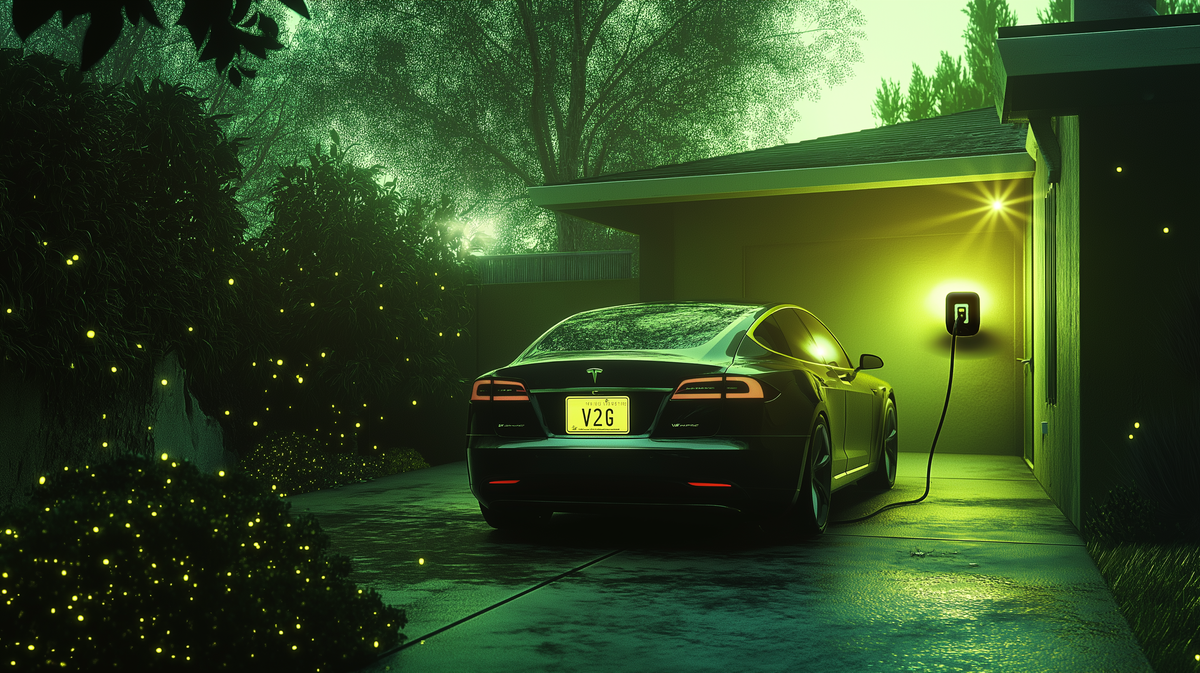By 2030, Smart Grids will Power a Greener World: An Energy Revolution #Trend
Explore the trend of Smart Grids revolutionizing the energy sector. By 2030, these intelligent systems will integrate renewables, enable two-way communication, and empower consumers as energy prosumers. Join the energy revolution and shape a greener, more sustainable future! ⚡🌍

Imagine a world where your refrigerator not only suggests meal ideas based on its contents but also schedules your appliances to run when energy costs are lowest. This isn't a scene from a futuristic novel—it's the realm of the Smart Grid. As we approach 2030, Smart Grids are not just a buzzword but a burgeoning reality set to revolutionize how we consume and interact with electricity. They’re the brainiacs of the energy world, transforming our once-dumb power grids into savvy networks that think, communicate, and adapt. ⚡ #SmartGrid
Visualize the Smart Grid as the ultimate energy conductor, orchestrating a harmonious dance between producers, distributors, and consumers. It’s like a symphony where everyone knows their part and plays in perfect harmony, avoiding those dreaded blackouts and high bills. With Smart Grids, your home could double as a mini power station, feeding energy back into the grid when demand peaks and saving you a pretty penny in the process. Who knew being part of the energy revolution could be this effortless and rewarding? 🌍 #EnergyInternet
In this blog, we’ll journey through the fascinating evolution of the Smart Grid, exploring its historical roots, its transformative impact today, and its promising future. From the pioneering figures who laid the groundwork to the exciting innovations on the horizon, we’ll uncover how Smart Grids are poised to power a greener and more connected world. Join us as we delve into the sections that reveal the smart revolution awaiting us all. 🚀 #SmartGridRevolution
Smart Grids: Energizing the Future of Electricity ⚡
The Smart Grid is a transformative innovation in the way we manage and distribute electricity. Unlike traditional grids, which operate on a one-way flow of electricity from power plants to consumers, smart grids enable a two-way flow of both electricity and information. This evolution is akin to giving our electricity network a brain, earning it nicknames like "the energy internet", the "the internet of energy" or "the electronet". By incorporating real-time data and communication technologies, smart grids offer a more efficient, resilient, and eco-friendly power system. 🌍 #SmartGrid
At the heart of a smart grid is the integration of Information and Communication Technologies (ICT). These technologies include sensors, wireless modules, and monitoring systems that collect and analyze data on electricity usage and consumption. This data is shared among all participants in the network—producers, distributors, and consumers—allowing for a dynamic balance between supply and demand. This smart balancing act not only helps in reducing electricity bills but also ensures a reliable power supply. #ICT
Decentralized Power Generation
Traditionally, power generation was centralized, with large plants like nuclear, coal, and gas stations supplying electricity over long distances. In contrast, the smart grid supports a decentralized model where numerous small producers, often using renewable sources like wind, solar, and hydro, contribute to the grid. This shift allows for local generation and consumption, reducing transmission losses and enhancing energy efficiency. It's like having a neighborhood bake sale instead of relying on a distant bakery for your bread. 🍞 #RenewableEnergy
Empowering Consumers
One of the most exciting aspects of the smart grid is the transformation of consumers from passive recipients of electricity to active participants in the energy ecosystem. Equipped with smart devices and energy storage solutions, consumers can now interact with the grid, supplying energy back when possible. This participatory approach not only empowers consumers but also supports energy exchange and storage, creating a more flexible and responsive energy system. It's like turning every home into a mini power station! 🏡 #EnergyExchange
The potential of consumers to actively interact with the grid will reach new heights when combined with innovations like Vehicle-to-Grid (V2G) technology, where electric vehicles serve as mobile energy sources.

The Role of Two-Way Communication
The smart grid's ability to facilitate a two-way flow of electricity and information is crucial for its operation. This feature enables utilities and consumers to communicate in real-time, optimizing energy distribution and consumption. For instance, during peak demand, utilities can send signals to smart appliances to reduce usage, preventing overloads and blackouts. This level of interaction ensures a stable and efficient power supply, much like a well-coordinated dance between supply and demand. 💃 #TwoWayCommunication
In essence, the smart grid represents a significant leap forward in how we manage electricity. By leveraging digital tools and real-time data, it transforms the traditional energy model into a more sustainable, participatory, and efficient system. As we continue to embrace this technology, the smart grid will play a pivotal role in shaping a greener and more resilient energy future. 🌿 #SustainableEnergy

The Rise of the Smart Grid: From Vision to Early Implementation ⚡
The concept of the Smart Grid emerged in the late 20th century as a response to the growing limitations of traditional power grids. These aging systems, which had served us well for decades, were increasingly seen as inefficient and unable to keep up with the rising demand for energy. The idea of a "smart" grid was born out of the necessity to integrate digital technology into the electrical grid, aiming to improve its reliability, efficiency, and sustainability. This vision was fueled by the need to tackle issues such as power outages, energy loss, and the integration of renewable energy sources. 🌍 #SmartGridOrigins
A significant milestone in the development of the Smart Grid was the Energy Policy Act of 2005 in the United States. This legislation laid the foundation for modernizing the nation's electricity infrastructure, encouraging the adoption of advanced technologies and practices to enhance grid performance. Around the same time, Europe and other regions were also exploring similar initiatives, recognizing the transformative potential of smart grids in energy management. The introduction of smart meters, which allowed for real-time monitoring of energy consumption, marked an early milestone in the transition towards smarter energy systems. 📈 #EnergyPolicy
Technological Innovations and Pioneering Figures
The advancement of the Smart Grid has been driven by numerous technological innovations and the efforts of key figures and organizations. The development of advanced sensors, communication networks, and data analytics has been crucial in enabling the grid to operate more intelligently. Companies like Siemens and General Electric have been at the forefront of this technological revolution, investing heavily in research and development to bring smart grid solutions to market. Additionally, government agencies and research institutions have played a significant role in funding and supporting smart grid projects, recognizing their potential to enhance energy security and sustainability. 🔍 #TechInnovation
Throughout its history, the Smart Grid has been shaped by the vision and leadership of influential figures in the energy sector. Experts like Massoud Amin, often referred to as the "Father of the Smart Grid," have been instrumental in advocating for the integration of digital technology into the electrical grid. Their work has helped to raise awareness about the benefits of smart grids, including improved energy efficiency, reduced carbon emissions, and enhanced resilience against natural disasters and cyber threats. These contributions have been vital in driving the global momentum towards smarter, more sustainable energy systems. 🌟 #SmartGridPioneers

The Current State of Smart Grid: Energizing Our World Today ⚡
In today's world, the Smart Grid is transforming the way we manage and consume electricity, integrating cutting-edge technologies to create a more efficient and reliable power system. At its heart, the Smart Grid uses digital communication technology to detect and respond to local changes in usage, enhancing the efficiency of energy distribution. This modern grid is not just about delivering electricity; it's about enabling two-way communication between utilities and customers, allowing for real-time monitoring and management of energy resources. This transformation is crucial as we strive to meet growing energy demands while minimizing environmental impact. 🌍 #SmartGrid
Recent advancements in renewable energy integration have been a game-changer for the Smart Grid. With the increasing adoption of solar panels, wind turbines, and other renewable sources, the grid must adapt to accommodate these intermittent energy supplies. Smart Grids are equipped with technologies that can dynamically balance supply and demand, ensuring that renewable energy is effectively harnessed and distributed. This capability is essential for reducing reliance on fossil fuels and achieving sustainability goals. Moreover, energy storage solutions, such as batteries, are becoming integral components of the Smart Grid, providing backup power and stabilizing the grid during peak demand periods. 🌞 #RenewableEnergy
Current Applications and Market Trends
The deployment of Smart Grid technologies is gaining momentum across various sectors. In urban areas, Smart Grids are enhancing the reliability of electricity supply, reducing outages, and improving response times to power disruptions. For consumers, smart meters are becoming commonplace, offering detailed insights into energy usage and enabling more informed decisions about consumption. This transparency empowers users to optimize their energy use, potentially lowering their bills and reducing their carbon footprint. In the industrial sector, Smart Grids facilitate more efficient energy management, helping businesses cut costs and improve operational efficiency. 🏙️ #SmartCities #EnergyEfficiency
Market trends indicate a robust growth trajectory for Smart Grid technologies. According to industry reports, the global Smart Grid market is expected to reach significant milestones in the coming years, driven by government initiatives and investments in grid modernization. Countries worldwide are recognizing the importance of upgrading their energy infrastructure to support economic growth and environmental sustainability. 🌍 #SmartGridGrowth
Challenges and Limitations
Despite its promising potential, the Smart Grid faces several challenges that need addressing. Cybersecurity is a major concern, as the increased connectivity and data exchange make the grid vulnerable to cyberattacks. Ensuring the security and privacy of data is paramount to maintaining trust in these systems. Additionally, the high upfront costs associated with deploying Smart Grid technologies can be a deterrent for some utilities, particularly in developing regions. Overcoming these financial barriers requires strategic investments and supportive policies from governments and stakeholders. 💰 #SmartGridChallenges #EnergySecurity
Another limitation is the complexity of integrating diverse energy sources and technologies into a cohesive system. The interoperability of different components and standards is crucial for the seamless operation of the Smart Grid. As the industry progresses, developing universal standards and protocols will be essential to facilitate collaboration and innovation. Despite these challenges, the Smart Grid represents a significant step forward in creating a sustainable and resilient energy future. With continued advancements and strategic efforts, we can harness the full potential of this transformative technology. 🔧 #EnergyInnovation #SustainableFuture

The Future of Smart Grids: Energizing a Connected World ⚡🌍
The future of Smart Grids promises to transform our energy landscape, with significant advancements anticipated in the coming years. By 2030, we expect a widespread rollout of Smart Meters and Advanced Metering Infrastructure (AMI) across urban and rural areas. This will empower consumers with real-time energy usage data, leading to increased energy efficiency and engagement. Imagine your toaster and thermostat working together to save you money! 😄 #SmartMeters #EnergyEfficiency
As we progress into the 2030s, the integration of renewable energy sources like solar and wind into the grid will become even more pronounced, supported by advancements in energy storage technologies. This era will also witness the rise of microgrids in communities, enhancing resilience against power outages. These microgrids will act like neighborhood superheroes, ready to swoop in and save the day when the main grid falters. 🌞🔋 #Renewables #Microgrids
Decentralization and Consumer Empowerment
Looking towards the 2040s, we anticipate the emergence of decentralized energy systems. With blockchain technologies facilitating peer-to-peer energy trading, consumers will evolve into "Prosumers", actively generating and trading energy. This shift will democratize energy production and spur innovation in energy management. Enhanced cybersecurity measures will be crucial to protect this new infrastructure, ensuring our energy systems remain secure from digital mischief-makers. 🤝🔐 #P2PEnergy #Blockchain
By the mid-21st century, artificial intelligence and machine learning will play pivotal roles in autonomous grid management. These technologies will enable real-time optimization of energy distribution and predictive maintenance of grid components. Electric Vehicles (EVs) will also become integral to grid storage solutions through Vehicle-to-Grid (V2G) technologies, operating as essential storage resources for grid stability. The future is electric, and it's going to be a wild ride! 🚗⚡🤖 #AI #V2G

Global Connectivity and Sustainability
Looking even further ahead, from 2060 onwards, we anticipate the transition towards a globally interconnected smart grid. This will facilitate efficient cross-border energy exchange and balancing, contributing to universal access to reliable and sustainable energy. Such a development will be a game-changer for global economic growth and environmental sustainability goals. Imagine a world where energy flows as freely as ideas across borders. 🌍🔌 #GlobalSmartGrid #Sustainability
While the future of smart grids is bright, it is not without challenges. The integration of diverse energy sources and technologies will require robust regulatory frameworks and international cooperation. Additionally, ensuring data privacy and cybersecurity will be paramount as connectivity increases. But with these challenges come opportunities for innovation and collaboration, paving the way for a more sustainable and efficient energy future. ⚖️ #EnergyChallenges #Innovation
Smart Grids: The Future of Energy is Here, Are You Onboard? ⚡🌍
As we've navigated through the electrifying world of Smart Grids, it’s clear that this burgeoning technology is poised to transform the way we interact with energy. From envisioning your home as a mini power station to the integration of two-way communication, Smart Grids are not just a futuristic dream but a reality in progress. These grids are making energy management more efficient, reliable, and eco-friendly, much like the symphony of energy innovation we all hoped for. 🌍 #SmartGrid
Looking to the future, Smart Grids promise even more revolutionary changes, from integrating renewable energy sources to empowering consumers as active participants in the energy ecosystem. As we edge towards 2030, the question isn't whether Smart Grids will transform our world, but rather how we can best harness their potential for a greener, more sustainable future. 🚀 #SmartFuture
Now, we want to hear from you! What are your thoughts on the Smart Grid revolution? Share your insights in the comments below. For those eager to stay informed, explore our other posts on emerging technologies and subscribe for the latest updates on trends shaping our world. 💬 #JoinTheConversation #EnergyInnovation
Timeline Projections: The Future of Smart Grids ⚡🌐
- 2025 - 2030: Accelerated deployment of Smart Meters and Advanced Metering Infrastructure (AMI) across urban and rural areas. Enhanced consumer engagement through real-time energy usage data, leading to increased energy efficiency. Integration of IoT devices for better demand response management. #SmartMeters #EnergyEfficiency
- 2030 - 2040: Significant integration of renewable energy sources like solar and wind into the grid, supported by advancements in energy storage technologies. Implementation of microgrids in communities to improve resilience against outages. 🌞🔋 #Renewables #Microgrids
- 2040 - 2050: Emergence of decentralized energy systems with peer-to-peer energy trading facilitated by blockchain technologies. Consumers become "prosumers," actively generating and trading energy. Enhanced cybersecurity measures to protect grid infrastructure. 🤝🔐 #P2PEnergy #Blockchain
- 2050 - 2060: Adoption of artificial intelligence and machine learning for autonomous grid management, enabling real-time optimization of energy distribution and predictive maintenance of grid components. Electric vehicles widely used as grid storage solutions through Vehicle-to-Grid (V2G) technologies. 🚗⚡🤖 #AI #V2G
- 2060 - 2075: Transition towards a globally interconnected smart grid, facilitating efficient cross-border energy exchange and balancing. Universal access to reliable and sustainable energy contributes to global economic growth and environmental sustainability goals. 🌍🔌 #GlobalSmartGrid #Sustainability
References: * Powering Up the Future: The Smart Grid Revolution ⚡🔌
- “An Introduction to Smart Grid” — https://www.ecomena.org/smart-grid/
- “Smart grids - IEA” — https://www.iea.org/energy-system/electricity/smart-grids
- “Smart Grid - an overview | ScienceDirect Topics” — https://www.sciencedirect.com/topics/engineering/smart-grid
- “Smart Grid: A Beginner's Guide” — https://www.nist.gov/el/smart-grid-menu/about-smart-grid/smart-grid-beginners-guide
- “Smart grid” — https://en.wikipedia.org/wiki/Smart_grid


